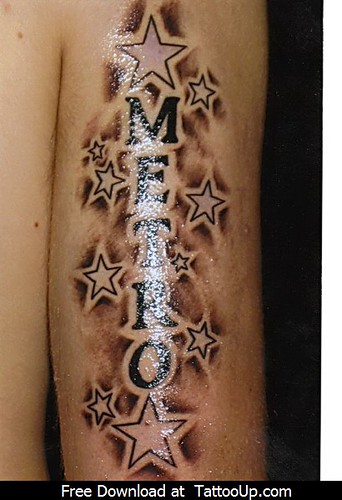
Image : http://www.flickr.com
I was recently asked a question on our website that I thought deserved a lengthy answer.
J.C. of Buffalo, NY asks: "I have diabetes and I take insulin. Is there any reason I should be concerned about getting a tattoo?"
So, J.C, you're thinking about getting a tattoo, but you have diabetes. Is this a good idea? Well, in most cases it's not a problem. But there are some things you should be thinking about before during and after the inking process.
During my 18 years in podiatric practice I thought I had seen everything, that is until one day I was called to the emergency department for a consultation. A 45 year old female diabetic patient decided to get a tattoo on the top of her foot. She said she thought nothing of it at the time. It was a rendering of her late cat whom she loved so much. About 3 days after the inking she began to develop some redness around the site. She followed the directions given to her, but the redness got worse. She applied more ointment but now she could see the redness spreading away from the tattoo. She consulted her tattoo artist who intuitively had her call her physician who sent her immediately to the emergency department.
A tattoo for all practical purposes is an intentional wound. This young woman had gotten an infection and because she had the circulation of an 80 year old and because of neuropathy she did not feel any pain. What she did have was an abscess on the top of her foot. This led to the circulation becoming worse leading to gangrene of the toes. She ultimately lost half her foot. I was able to save the remaining foot, by cleaning out the infected bone and soft tissue, and using high tech state of the art wound healing products and treatments.
Let's discuss a little about diabetes first. Diabetes is the leading cause of non-traumatic foot and leg amputations in the United States and approximately 14 to 24 percent of patients with diabetes who develop a foot ulcer and infections go on to have an amputation. Research, however, has shown that the development of a foot ulcer is preventable.
Anyone who has diabetes can develop a foot ulcer or an infection. Native Americans, African Americans, Hispanics and older men are more likely to develop ulcers. People who use insulin are at a higher risk of developing a foot ulcer, as are patients with diabetes-related kidney, eye, and heart disease. Being overweight and using alcohol and tobacco also play a role.
Diabetic complications develop due to a combination of factors, such as lack of feeling in the foot, poor circulation, foot deformities, irritation (such as friction or pressure), and trauma, as well as duration of diabetes. Patients who have diabetes for many years can develop neuropathy, a reduced or complete lack of feeling in the feet and legs due to nerve damage caused by elevated blood sugar levels over time. The nerve damage often can occur without pain and one may not even be aware of the problem. "
"Vascular disease can complicate a healing tattoo, reducing the body's ability to heal and increasing the risk for an infection. Elevations in blood glucose can reduce the body's ability to fight off a potential infection and also slow down the entire healing process."
Most tattoos do not get infected; however if your physician diagnoses an infection, a treatment program of antibiotics, wound care, and possibly hospitalization will be necessary.
necessary.
There are several important factors to keep a
tattoo from becoming infected:
Keep blood glucose levels under tight controlKeep the tattoo clean and bandaged. Cleanse the tattoo daily, using a wound dressing or bandage. The science of wound care has advanced significantly over the past ten years. The old thought of "let the air get at it" is now known to be harmful to healing. We know that wounds including tattoos and ulcers heal faster, with a lower risk of infection, if they are kept covered and moist. The use of full strength betadine, peroxide, whirlpools and soaking are not recommended, as this could lead to further complications.
Appropriate wound management includes the use of dressings and topically-applied medications. These range from normal saline to advanced products that have been shown to be highly effective in healing problem tattoos.
For a tattoo to heal there must be adequate circulation to the inked area. A circulation specialist (vascular surgeon) or a podiatrist can determine circulation levels in the feet and legs with noninvasive tests.
Healing time depends on a variety of factors, such as tattoo size and location, pressure on the area from walking or standing, swelling, circulation, blood glucose levels, wound care, and what is being applied to the wound. Healing may occur within weeks or require several months.
The key to successful
tattoo healing is to ensure the following "gold standard" of care:
lowering blood sugar treating any infection reducing friction and pressure restoring adequate blood flowThe old saying, "an ounce of prevention is worth a pound of cure" was never as true as it is when preventing a diabetic tattoo complication.
Dr. Hal Abrahamson is a Board Certified Podiatrist in New York, and the Chief Medical Officer of Biker Skin Care Products [http://www.bikerskincare.com], a company that produces tattoo aftercare products [http://www.bikerskincare.com/index.asp?PageAction=VIEWPROD&ProdID=7] and foot care products [http://www.bikerskincare.com/index.asp?PageAction=VIEWCATS&Category=3]. Dr. Abrahamson is also a member of the Suffolk County Board of Health and Tattoo Advisory Panel, and is a motorcycle and muscle car enthusiast.






























